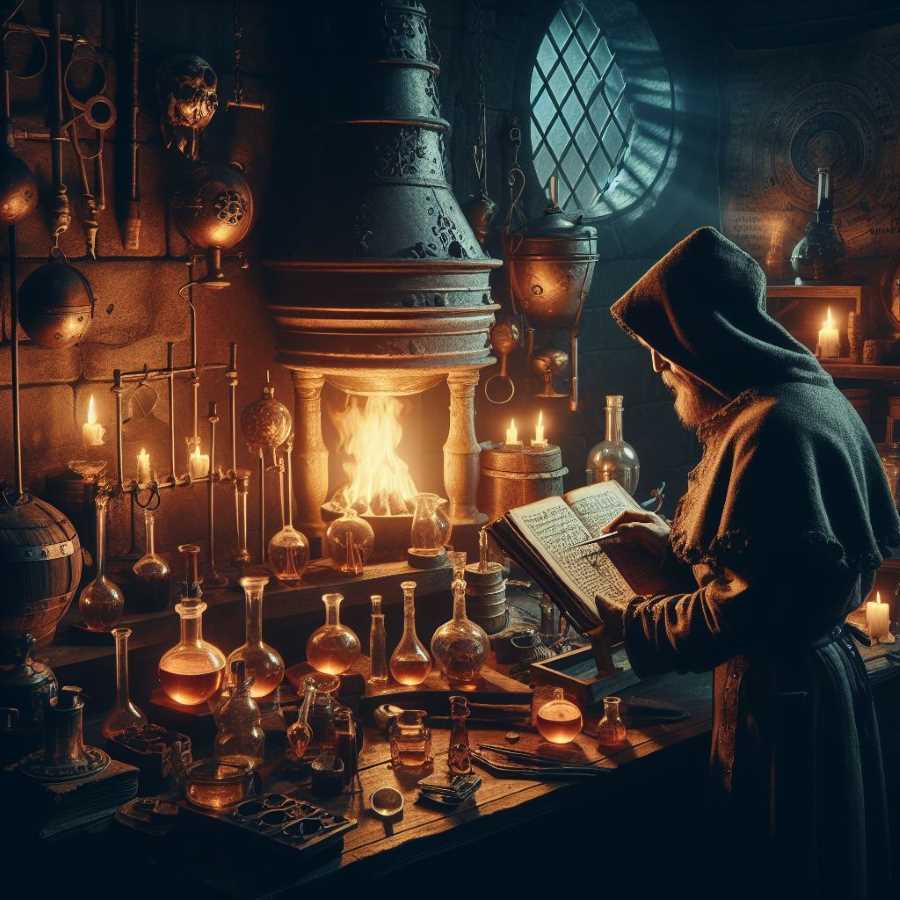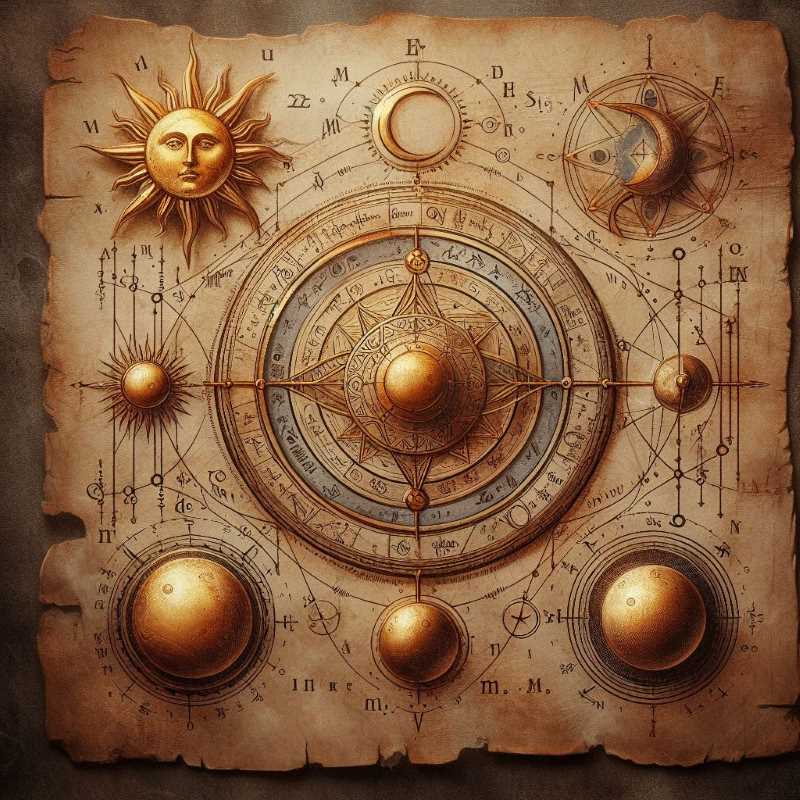How Metallurgy and Mysticism Birthed Chemistry
Chemistry's origins lie in ancient crafts like metallurgy and Egyptian arts. Alchemy emerged in Alexandria, blending practical knowledge with Greek philosophy. Alchemists sought to transmute metals and create elixirs, developing symbolic language and potent acids.

The sleek glassware and precise equations of a modern chemistry lab seem a world away from the smoke-wreathed workshops of ancient alchemists. Yet, the story of chemistry is one of slow metamorphosis, not sudden birth. It's a tale etched in the soot-stained hands of early artisans and the cryptic symbols scrawled upon crumbling parchments.
Let's rewind two million years. Picture the flicker of a campfire casting long shadows on the faces of our early ancestors. As they coaxed shimmering copper from dull rocks, they unknowingly stumbled upon metallurgy – humanity's first great chemical experiment. This was chemistry in its most primal form: the manipulation of matter to create something new and useful.
Across the ancient world, this hunger for transformation blossomed. Egyptians, masters of vibrant pigments and potent potions, ground minerals into cosmetics and extracted fragrant oils from plants. Mesopotamian brewers and bakers, with their bubbling vats and ovens, unknowingly harnessed the power of fermentation – another form of chemical change. These were the practical pioneers, laying the groundwork for a more systematic investigation of matter.
Then, in the 3rd century BC, a crucible of cultures ignited in the bustling city of Alexandria. Here, Egyptian artisans, steeped in age-old techniques of dyeing, glassmaking, and metalwork, collided with the rigorous philosophy of the Greeks. From this unlikely union, alchemy was born.
The word 'alchemy' itself carries the meaning of this heritage – 'al-kîmiya,' a term with roots in 'Kemi,' the ancient name for Egypt, the land of secrets and transformative arts. Alchemists, driven by audacious dreams, set out on a quest to unravel the fundamental nature of matter. Could they transmute lead into gleaming gold? Was there an elixir potent enough to defy death itself?
To us, these goals might seem fantastical. Yet, fueled by this feverish pursuit, alchemists made remarkable strides. They mastered techniques like distillation, investigated the properties of acids, and developed a cryptic language of symbols to record their work. Like sorcerers surrounded by bubbling retorts, they associated metals with heavenly bodies – gold with the fiery sun, delicate copper with Venus, and iron with the warlike Mars. Interestingly, some of these symbols remain with us today, subtle remnants of our alchemical past.
Alchemy, like a tireless traveler, crossed continents and oceans. In China, the quest for elixirs fueled innovations in medicine and gunpowder. Arab scholars, with their zeal for knowledge, embraced alchemy with open arms, leaving their mark on the discipline with the discovery of powerful acids.
As the Middle Ages gave way to the Renaissance, a shift occurred. Alchemy, still swirled with mysticism, began to embrace a more rigorous, evidence-based approach. Thinkers like Paracelsus, a controversial yet brilliant figure, saw the link between chemicals and health. While their practices might raise a modern physician's eyebrows, they mark the first tentative steps towards modern medicine.
Gradually, alchemy shed its mystical trappings, giving birth to the 'rational' science of chemistry we know today. Yet, echoes of the past linger. The word 'elixir,' the quest to understand the building blocks of matter, and even the glassware used in modern laboratories – these are all subtle reminders of our alchemical inheritance.

Deciphering Symbols and the Search for the Divine
Alchemy, that enigmatic blend of science, philosophy, and a touch of the mystic, has left an indelible mark on our world. At its core lay a thirst to unlock the hidden language of matter – a code alchemists believed would reveal the secrets to transmuting base metals into gleaming gold and perhaps even achieving eternal life.
Like scholars of an arcane text, alchemists developed a cryptic web of symbols to record their work. This wasn't merely for practical secrecy; it held deeper significance. They envisioned the universe as a grand web with celestial connections. Heavenly bodies like the Sun (gold) and the Moon (silver) were intertwined with fundamental elements like sulfur and mercury. These symbols were their map, each stroke imbued with hidden meaning.
The alchemist's workshop was a realm where the physical and the metaphysical blurred. Metals were not just lifeless matter; they embodied divine characteristics. Iron, strong and unyielding, echoed the might of Mars, the god of war. Copper, with its warm glow and malleable nature, mirrored the beauty and grace of Venus. Interestingly, echoes of this symbolism persist — the intertwined male and female symbols harken back to their alchemical origins.
These symbols and associations weren't just abstract concepts; they held the promise of tangible power. Alchemists believed the universe was built upon opposing forces of sulfur and mercury, representing the Sun and Moon, day and night. By manipulating these elements in perfect harmony, they dreamed of creating legendary substances.
The Philosopher's Stone was the ultimate prize – a mystical catalyst whispered to transform lead into gold. This wasn't just about material wealth; it symbolized the pinnacle of understanding and control over matter itself. Yet, the quest wasn't always rooted in greed. Figures like Arnold of Villanova sought the Elixir of Life, a substance imagined purging toxins, rejuvenate the body, and restore lost youth. These mirrored age-old human desires: to conquer death and unlock the secrets of vitality.
It's easy to dismiss alchemy as mere superstition, but beneath the fantastical aims lay tangible progress. Alchemists tirelessly experimented, mastering distillation, studying acids, and cataloging the properties of various substances. Their pursuit of the impossible helped lay the foundations for modern chemistry.
Moreover, their influence seeped beyond the laboratory. Alchemical symbolism and philosophies permeated art, literature, and even our understanding of the human body. The quest for an inner elixir mirrored the search for spiritual enlightenment, and alchemical processes mirrored our own potential for transformation.
While the Philosopher's Stone and the Elixir of Life remain elusive, alchemy itself has achieved a kind of immortality. Its symbols linger in our modern world, and its spirit of relentless inquiry lives on in every scientist who seeks to unravel the mysteries of the world around us. After all, isn't the essence of science a desire to transmute knowledge into something powerful, transformative, and ever-lasting?

From Egyptian Sands to European Laboratories
Alchemy was never a stagnant discipline; its ideas flowed and mingled like the mercury so prized by its practitioners. As it journeyed across continents and through the centuries, it absorbed the wisdom of diverse cultures, transforming itself anew with each encounter.
The Arab conquests of Egypt, Syria, and Persia marked a turning point. Arab scholars, renowned for their intellectual curiosity and thirst for knowledge, breathed fresh life into alchemy. Figures like the legendary Jabir Ibn Hayyan emerged, pushing the boundaries of the discipline with discoveries like aqua regia ('royal water'), the potent acid capable of dissolving even gold. It was a testament to the Arab alchemists' rigorous experimentation and their desire to understand the fundamental nature of matter.
Meanwhile, back in Europe, alchemy flourished in the vibrant centers of learning. Yet, even here, the echoes of Arab innovations could be heard. Alchemical texts flowed along trade routes, carrying not only formulas but also a spirit of relentless inquiry.
By the Middle Ages, alchemy had become a sprawling, multifaceted realm. One faction clung to the age-old dream of transmuting base metals into gleaming gold. These gold-seekers, driven by a mix of greed and genuine curiosity, were the stereotypical alchemists of our imagination, hidden in dimly lit chambers amidst bubbling alembics.
Yet, there existed another lineage – the 'adepts.' These were the scholars of alchemy, seeking not just material riches, but a more profound understanding of nature. While experimentation was their cornerstone, it was intertwined with a rich tapestry of philosophy and mysticism. Thinkers like Paracelsus viewed the human body as a microcosm, a miniature reflection of the grand cosmic order. This belief system, known as Hermetic alchemy, permeated their work, infusing it with a sense of the sacred and the hidden.
Hermetic alchemists were the masters of the cryptic. Their writings overflowed with arcane symbols, allegories, and references to the occult. This wasn't mere obfuscation; it reflected their belief that true understanding lay beyond the surface, accessible only to the initiated. It created an aura of mystery and exclusivity around alchemy, adding to its enduring allure.
The excerpt from Mika Waltari's 'Sinhué the Egyptian' captures a profound truth about alchemy – it was as much about the heart as it was about the mind. Alchemists, whether chasing gold or chasing higher knowledge, were bound by a shared yearning. It was a yearning to understand and ultimately control the world around them. It was a yearning, perhaps, as timeless as humanity itself.
Though the grand dreams of transmutation and immortality faded, alchemy's legacy lives on. Modern chemistry owes its foundation to the tireless experiments of these early seekers. But alchemy's influence extends far beyond beakers and test tubes. Its symbolism echoes in art and literature. Its quest for transformation mirrors our own desires for self-improvement and a better world.
In the end, alchemy is a reminder that science is never a sterile endeavor. It's fueled by curiosity, imagination, and a deep-seated yearning to decode the secrets of the universe – a yearning as old as the first humans who gazed in wonder at a starlit sky.
In-text Citation: (Arbiza, 2000, pp. 53-55)




